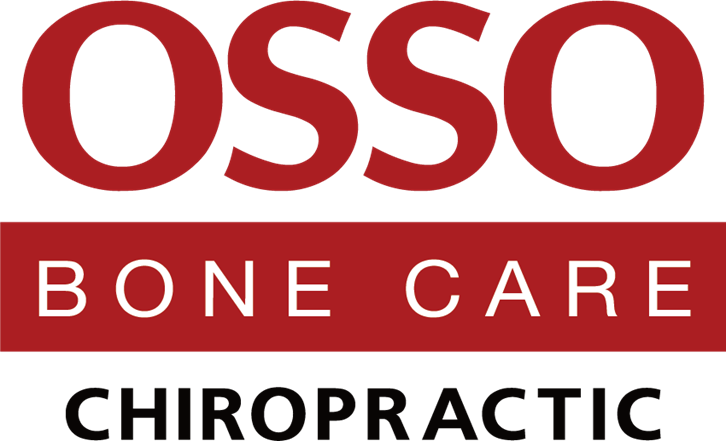Sitting Silently Damages Your Spine – Even If You Don’t Feel The Pain Yet!
We all love a good Netflix marathon, a comfy office chair, or a long drive with our favorite playlist. But here’s something most people don’t realize — sitting still for hours can quietly damage your spine, even if you don’t feel any pain right now.
That’s right. The ache you notice only after standing up, or that mild stiffness in your lower back after a day at your desk, isn’t just “part of getting older.” It’s your spine waving a little red flag. What really happens when you sit too long? And what can you do to protect your back before pain becomes your daily companion?
At Osso Bone Care, we’ve seen firsthand how “sitting still” leads to silent degeneration. And most people don’t realize the damage until it’s too late.
Why Sitting Hurts More Than You Think
If you’ve ever said, “My back pain hurts to sit,” you’re not alone. It’s one of the most common complaints doctors hear.
When you sit, your spine takes on more load than when you stand. It may sound backward, but it’s true. Sitting actually increases pressure on your spinal discs by up to 40% (A Nachemson, 1999, Clin. Orthop. Relat. Res). That pressure compresses the cushioning between your vertebrae and forces your muscles to work less.
The result? Your spine starts to lose its natural alignment. This is one of the main reasons many people develop back pain when sitting, especially in the lower back.
Think about how your day goes:
- Sitting at your desk for 8 hours.
- Driving home in traffic.
- Having dinner, then sitting again to unwind.
That’s nearly 10–12 hours of sitting and your spine is taking the hit. Even if you feel fine now, the damage can accumulate quietly over time.
Early Warning Signs Before Pain Starts
A common misconception we hear is, “If there’s no pain, there’s no problem.” Unfortunately, that’s not how the spine works. Pain is often the final warning sign—the body’s last resort to get your attention after years of silent strain and degeneration.
Long before any ache or stiffness appears, your spine may already be undergoing subtle but serious changes:
- Ligament strain – Constant sitting or poor posture slowly overstretches the ligaments that stabilize your spine.
- Muscle imbalance – Some muscles weaken while others tighten, pulling your spine out of alignment.
- Disc dehydration – The discs between your vertebrae lose moisture and cushioning, reducing their ability to absorb pressure.
- Spinal or pelvic misalignment – Tiny shifts in alignment can disrupt your posture, balance, and even nerve function.
The tricky part? You can feel perfectly fine while all this is happening. That’s why many patients are shocked when we show them their Full Spine + Pelvic Digital X-ray results. Even without pain, these images often reveal the early stages of degeneration — changes that, if ignored, can lead to chronic discomfort or mobility issues later on.
Early detection allows for early correction. With chiropractic care, these underlying imbalances can often be addressed before they turn into something painful and harder to reverse.
What We See in Long-Time Office Workers
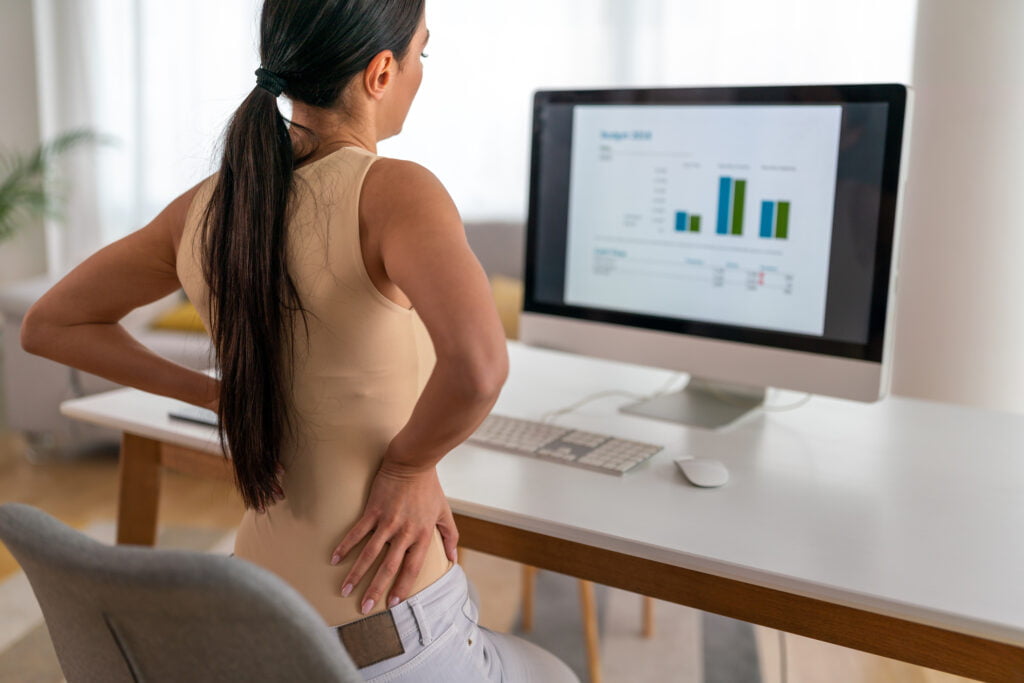
It’s easy to underestimate the toll that years of sitting can take on your spine. Many long-time office workers — those who’ve spent 5 to 10 years at a desk — come in thinking their back is fine. After all, they’ve never lifted anything heavy or had an injury. Yet, the scans and posture assessments often tell a different story.
Common issues we observe include:
Disc height reduction: When you sit for long hours, spinal discs lose hydration and elasticity. This makes them thinner, which can cause stiffness and reduced flexibility.
Pelvic tilt or rotation: Poor sitting posture can make your pelvis tilt forward or backward, leading to uneven strain on your lower back. One common habit—sitting with your legs crossed—can worsen this by creating imbalance between the hips, leading to asymmetrical loading of the spine and increasing the risk of long-term misalignment.
Forward head posture: Constantly leaning toward a screen shifts the head’s weight forward, putting extra pressure on the neck and upper spine.
Uneven shoulders or hips: Imbalanced sitting like crossing one leg or leaning to one side creates asymmetry in your body alignment.
Early disc bulges or slipped discs: When pressure builds unevenly, spinal discs can start to bulge, pressing on nerves and leading to pain or numbness.
And the reaction we often hear?
“But I only sit!”
Exactly. And that’s the problem.
Sitting seems harmless because it’s passive, but it’s the sustained lack of movement that gradually breaks down your body’s natural alignment and resilience. The longer it continues, the harder it becomes for your spine to recover without targeted care and correction.
Can This Back Pain Worsen?
Yes, lower back pain from sitting can absolutely worsen if the root cause isn’t addressed.
When you sit for long periods, especially with poor posture, your spine is constantly under uneven pressure, especially the L4–L5 and L5–S1 segments.
The natural S-curve of your spine begins to flatten, which causes certain muscles (like your hip flexors and lower back muscles) to tighten, while others (like your core and glutes) weaken. Over time, this imbalance leads to chronic strain on your lumbar spine.
If ignored, the pain can progress from mild discomfort to persistent or even disabling pain. Some people start feeling sharp pain when standing up, walking, or even while resting. In more severe cases, prolonged compression can cause:
- Degenerative disc changes, where the discs lose flexibility and height.
- Sciatica, if a disc or tight muscle irritates the sciatic nerve.
- Joint inflammation in the lower spine (facet joints).
- Reduced mobility, leading to stiffness and muscle fatigue even with short sitting periods.
Even worse, many people adapt by shifting positions or slouching further, which temporarily relieves pressure but actually worsens the structural misalignment over time.
Why Full Spine X-ray Matters for Sedentary Lifestyles
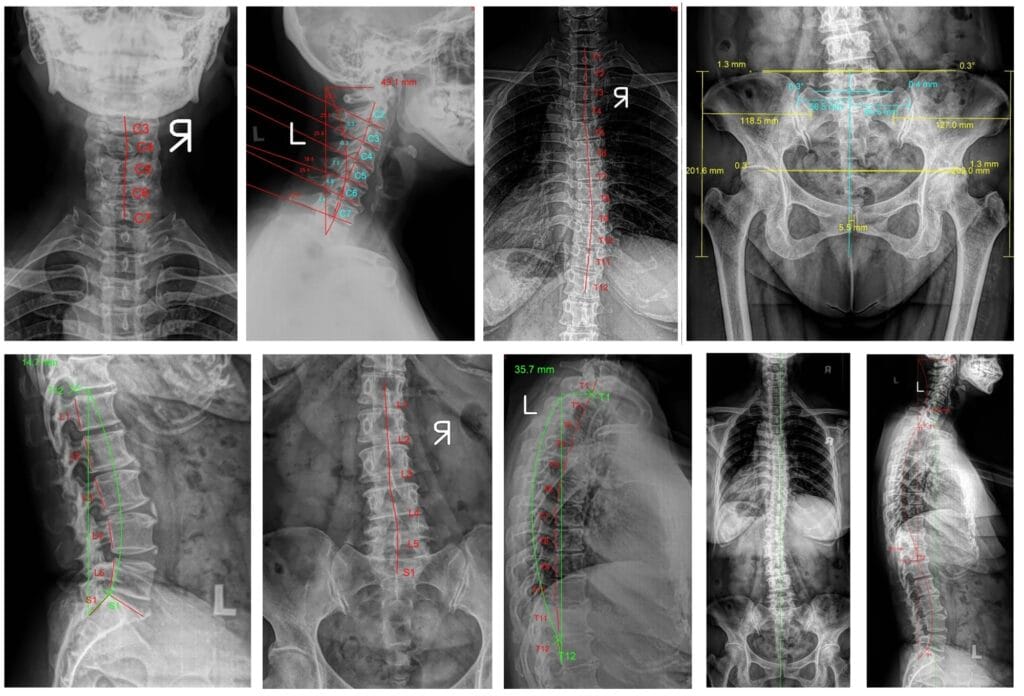
For people who spend most of their day sitting, whether at a desk, in the car, or in front of a screen, the spine is under constant, low-grade stress. Over time, these small, repetitive strains add up, often leading to postural distortion, stiffness, or pain that seems to appear “out of nowhere.” But in truth, the damage has been building silently for years.
That’s why at Osso Bone Care, we don’t just look at the spot that hurts. We take a full spinal approach using advanced Digital X-rays to understand what’s really happening beneath the surface. These scans can reveal what the naked eye can’t:
- Long-term postural stress patterns – The subtle curves and shifts that develop from years of slouching or leaning to one side.
- Misalignments from prolonged sitting – Small spinal shifts that disrupt how your body balances weight and movement.
- Disc space narrowing in early stages – One of the first signs of spinal wear that can eventually lead to bulging or herniated discs.
- Pelvic tilts from poor sitting posture – When one side of the pelvis rotates or drops, it can throw the entire spine off balance.
By analyzing these details, our chiropractors can tailor treatments to your specific spinal structure—not just your symptoms. This is where our signature methods like the Osso Flexion Distraction Technique®, 3D Spinal Decompression, and Pelvic Rebalancing come in.
Each of these treatments is designed to restore alignment, relieve nerve pressure, reduce pressure in the spinal disc and promote healthy spinal motion, helping to undo years of sitting-related strain safely and effectively.
What You Can Do (Before It’s Too Late)
You don’t need to overhaul your entire lifestyle to protect your spine—just start with small, consistent habits. The earlier you act, the easier it is to prevent lasting spinal damage.
Take short breaks every 30–45 minutes
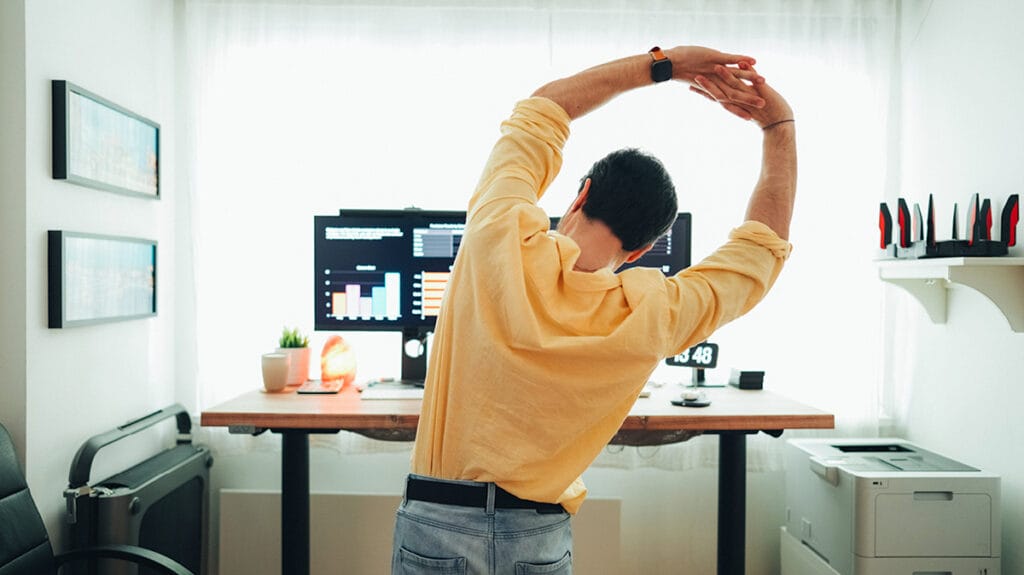
Your spine isn’t designed for hours of stillness. Standing, walking, or even gentle stretching resets circulation and relieves pressure on your lower back. Set a reminder or use a standing desk if you tend to lose track of time.
Strengthen your core and postural muscles

A strong core acts like a natural back brace, helping you maintain proper alignment and reduce strain. Try exercises like planks, bridges, or resistance band pulls to stabilize your spine and shoulders.
Invest in ergonomic support
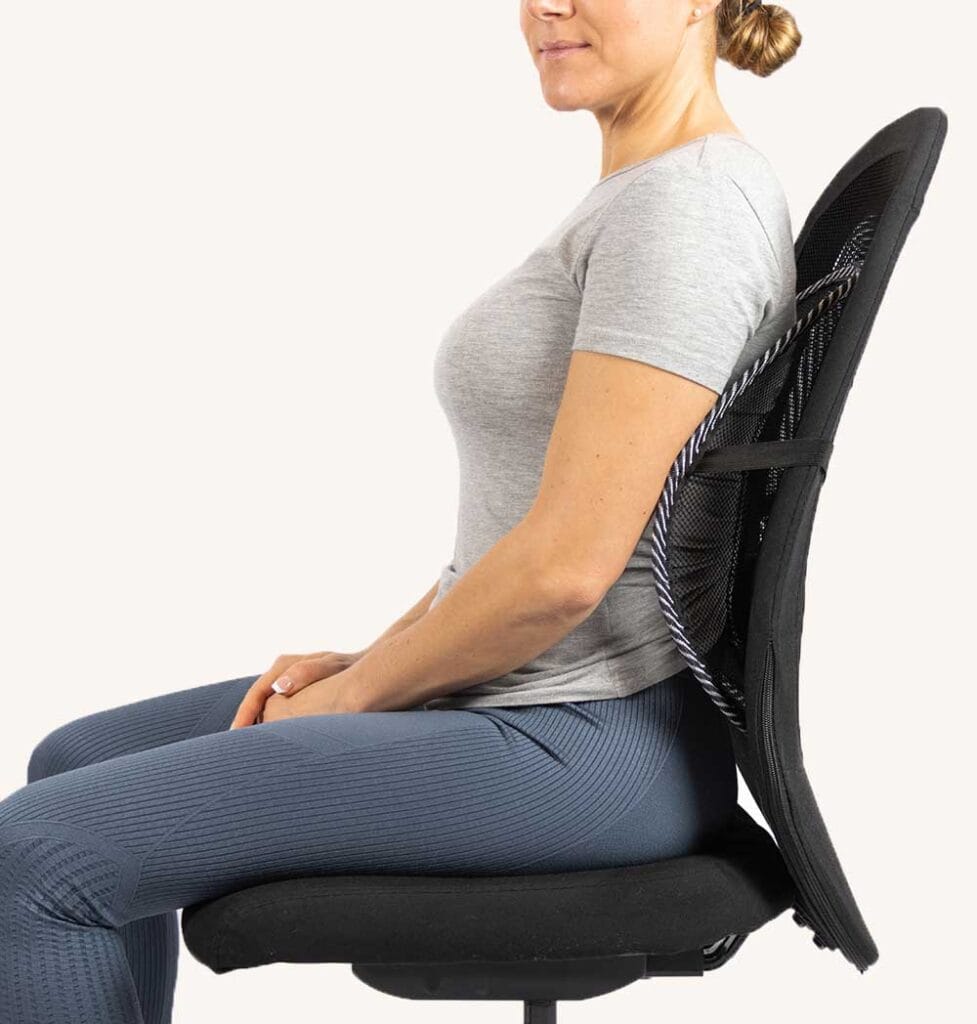
Your chair should fit you, not the other way around. Look for one with adjustable height, lumbar support, and a seat that keeps your knees at hip level. If you’re not ready for a full upgrade, lumbar supports like our Osso L5 can provide the same spinal reinforcement and comfort for daily sitting.
Book a spinal check-up even if you feel fine
Pain isn’t the first sign of trouble; it’s often the last. Regular spinal assessments can detect misalignments and stress points before they become serious problems.
The key takeaway? Don’t wait for pain to be your wake-up call. Prevention is easier, faster, and far less painful than treatment after damage has set in.
Healthy Sitting Habits vs Unhealthy Sitting Habits
| Healthy Sitting Habits | Harmful Sitting Habits |
|---|---|
| Sit upright with your shoulders relaxed and back supported. | Slouching or hunching forward over your desk or phone. |
| Keep feet flat on the floor and knees at a 90° angle. | Crossing legs or sitting on one leg, which twists the spine. |
| Take short breaks every 30 minutes to stand, stretch, or walk. | Sitting for hours without moving, reducing blood flow and oxygen to your spine. |
| Use a supportive chair with lumbar support or a cushion. | Using soft couches or non-ergonomic chairs that cause your spine to sag. |
| Position your screen at eye level to avoid neck strain. | Looking down at laptops or phones for long periods. |
| Engage your core muscles when sitting and try light desk stretches. | Leaning on one side or letting your core go completely relaxed. |
Protect Your Spine with Osso Bone Care Chiropractic
Here’s the truth: sitting silently damages your spine, long before pain begins. The longer you wait to make changes, the harder it is to undo the damage. So stand up. Stretch. Walk around. Your spine just needs a few small breaks throughout the day.
And if you feel like the pain is getting worse, especially in your lower back, chiropractors can help with any underlying issues and relieve your discomfort.
